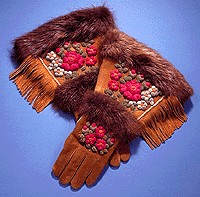 |
Gloves, Slavey, 1957; made by Bella Bonnetrouge, Fort Providence, Northwest Territories; smoked moosehide, moose hair, beaver fur.
CMC VI-N-33
In the nineteenth century, Métis who traced their origins to the Red River area of Manitoba were important agents of change with respect to Dene clothing fashions and decorative art.
A style of decorative work known as "tufting" was introduced about 1915 by a Métis woman, Mrs. Boniface Lafferty. In this technique, flowers and leaves are created by inserting a small bundle of moose or caribou hairs under a loop stitch, then pulling the stitch tight and fastening it off. The hairs are fanned out on either side of the stitch and trimmed with scissors to create a smooth, rounded effect.
Mrs. Lafferty taught this method to her daughter-in-law, who in turn taught a nun, Sister Beatrice Leduc. Under Sister Leduc's instruction in the convent school at Fort Providence, a number of Dene and Métis girls and women became skilled at such work, and it later spread to other communities. On clothing, hair tufting is most often used to decorate mittens, gloves, and footwear.
|

![]()

![]()